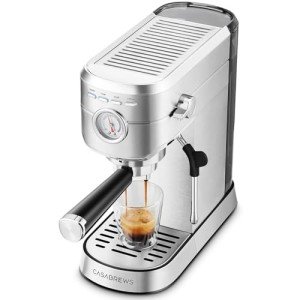Heat Exchange Espresso Machines: A Comprehensive Guide
Espresso machines have evolved considerably over the years, dealing with the needs of home baristas and coffee professionals alike. Amongst these machines, heat exchange espresso machines have actually gained popularity due to their ability to deliver constant performance and exceptional brew quality. In this short article, we will explore the operations, benefits, and important features of heat exchange espresso machines, providing a thorough understanding for both prospective purchasers and coffee enthusiasts.
Comprehending Heat Exchange Technology
Heat exchange espresso machines run on a special principle that permits simultaneous water heating for developing and steaming. They are equipped with a single boiler that uses a heat exchanger system. This feature is considerable as it allows users to brew espresso while steaming milk simultaneously, promoting effectiveness in the coffee-making process.
How Does a Heat Exchange Espresso Machine Work?
The process starts with the machine's water inlet filling the boiler. As the water warms up, it turns to steam. The innovative heat exchanger uses hot steam to heat extra water in a different passage created particularly for the brew group. This indicates that water can reach the perfect brewing temperature level without awaiting the boiler to adjust. The key actions include:
- Water Fill: Water is drawn into the boiler.
- Heating Process: The boiler warms up as water is transformed into steam.
- Heat Exchange: Steam heats water in the heat exchanger tube.
- Brewing: Water from the heat exchanger is pushed through coffee premises, extracting the flavors needed for an abundant espresso.
This procedure permits quick temperature modifications and enhanced coffee extraction.
Benefits of Heat Exchange Espresso Machines
Heat exchange espresso machines offer several advantages, particularly for those seeking to maximize their coffee experience. Here are some crucial advantages:
- Simultaneous Brewing and Steaming: Users can brew espresso while steaming milk, making it ideal for busy coffee shops and home baristas who value effectiveness.
- Temperature Stability: The boiler's steam pressure helps maintain a steady temperature level, which is crucial for consistent espresso extraction.
- Versatility: The design permits quick changing in between brewing and steaming, making it simpler to create different coffee drinks, from lattes to cappuccinos.
- User-friendly: Models often include available controls, making it feasible for both beginners and skilled baristas to produce quality drinks.
- Professional Quality: Heat exchange machines are often utilized in commercial settings, providing users with high-quality brewing performance in the house.
Key Features to Look for in Heat Exchange Espresso Machines
When considering the purchase of a heat exchange espresso machine, there are several features that a person should take into account:
- Build Quality: Look for machines made of resilient products, such as stainless steel or brass, guaranteeing longevity.
- Boiler Size: A larger boiler will hold more water and sustain greater output in time.
- PID Temperature Control: This feature helps preserve constant brew temperatures, which can boost the coffee-making procedure.
- Group Head Design: Machines with a saturated or semi-saturated group head supply much better temperature level stability.
- Ease of Use: User-friendly user interfaces and instinctive controls enhance the overall experience for baristas at all skill levels.
- Steam Wand Quality: A great steam wand with appropriate insulation and flexibility enables better texturing of milk.
- Water Reservoir Size: Depending on your requirements, consider how often you want to refill the water tank.
Comparison of Popular Heat Exchange Espresso Machines
To much better comprehend the alternatives offered in the market, listed below is a comparison table of some popular heat exchange espresso machines:
| Machine Model | Boiler Size | PID Control | Rate Range | User Ratings |
|---|---|---|---|---|
| Profitec Pro 700 | 2.0 L | Yes | ₤ 2,000-₤ 2,500 | 9.5/ 10 |
| Rocket Espresso R58 | 1.8 L | Yes | ₤ 2,400-₤ 2,800 | 9.4/ 10 |
| Elekta Bianca | 1.8 L | Yes | ₤ 2,500-₤ 3,000 | 9.6/ 10 |
| La Spaziale S1 Vivaldi II | 1.5 L | Yes | ₤ 1,800-₤ 2,200 | 9.2/ 10 |
| Bezzera Magica | 1.2 L | No | ₤ 1,600-₤ 1,800 | 9.0/ 10 |
Frequently Asked Questions About Heat Exchange Espresso Machines
What is the main distinction between a heat exchange and a dual boiler espresso machine?
While both types can brew espresso and steam milk at the very same time, dual boiler machines have different boilers for developing and steaming. On the other hand, heat exchange machines make use of a single boiler and a heat exchanger to achieve the very same function.
Are heat exchange machines suitable for novices?
Yes! Black Espresso Machines are designed with user-friendly functions, making them accessible for newbies. With proper assistance and practice, users can rapidly produce quality espresso.
What sort of maintenance do heat exchange espresso machines need?
Regular maintenance includes descaling, cleaning the boiler, examining seals and gaskets, and keeping the group head clean. Regular maintenance guarantees longevity and consistent performance.
Can I use a heat exchange machine for various types of coffee beverages?
Absolutely! Heat exchange machines enable users to develop a variety of coffee drinks, consisting of espresso, lattes, cappuccinos, and more.
Heat exchange espresso machines represent a blend of development and tradition, supplying coffee lovers with the tools required for crafting the perfect cup. Their capability to concurrently brew and steam, combined with precise temperature control, makes them an engaging option for both home baristas and specialists. With the ideal understanding on features and upkeep, users can unlock a world of beautiful coffee experiences, guaranteeing that each sip is as delightful as the last.

